In the realm of canine nutrition, the question of whether dogs can consume peas sparks curiosity and concern among pet owners striving to provide optimal diets for their furry companions.
While peas offer a plethora of nutrients beneficial to dogs, nuances surrounding their suitability and potential risks in canine diets require careful consideration.
Exploring the intricacies of incorporating peas into dogs' meals unveils a realm of factors crucial for informed decision-making.
As we navigate the complexities of this legume's role in our dogs' nutrition, staying informed on the dos and don'ts becomes imperative.
Key Takeaways
- Peas offer fiber, protein, and vitamins safe for dogs.
- Nutrient-rich peas support digestion, weight, heart health.
- Preparation is key; cook peas and avoid choking hazards.
- Consult a vet before feeding peas to ensure safety.
Safety of Peas for Dogs
Peas are considered safe for canine consumption and provide dogs with essential nutrients such as fiber, protein, and various vitamins. These nutrients play crucial roles in supporting a dog's overall health and well-being.
Fresh or frozen peas are preferable over canned peas due to lower sodium content and fewer additives. Peas, including snap peas, black-eyed peas, and chickpeas, can be included in moderation as part of a balanced diet for dogs. Ensuring that vegetables are cut into small, easily digestible pieces is recommended.
Along with peas, other safe vegetables for dogs include green beans, carrots, cauliflower, and sweet potatoes. Properly incorporating peas into a dog's diet can contribute positively to their nutritional intake and dietary variety.
Benefits of Peas for Dogs
Rich in essential nutrients and antioxidants, peas offer a multitude of health benefits for dogs when incorporated into their diet thoughtfully and in moderation. Peas are rich in vitamins A, K, and C, high in fiber and protein, and low in calories. They also contain antioxidants and are a good source of iron. The health benefits of peas for dogs include supporting digestive health, aiding in weight management, regulating blood sugar, promoting heart health, and boosting immunity.
| Health Benefits of Peas for Dogs |
|---|
| Supports Digestive Health |
| Aids in Weight Management |
| Regulates Blood Sugar |
| Promotes Heart Health |
Nutritional Value of Peas
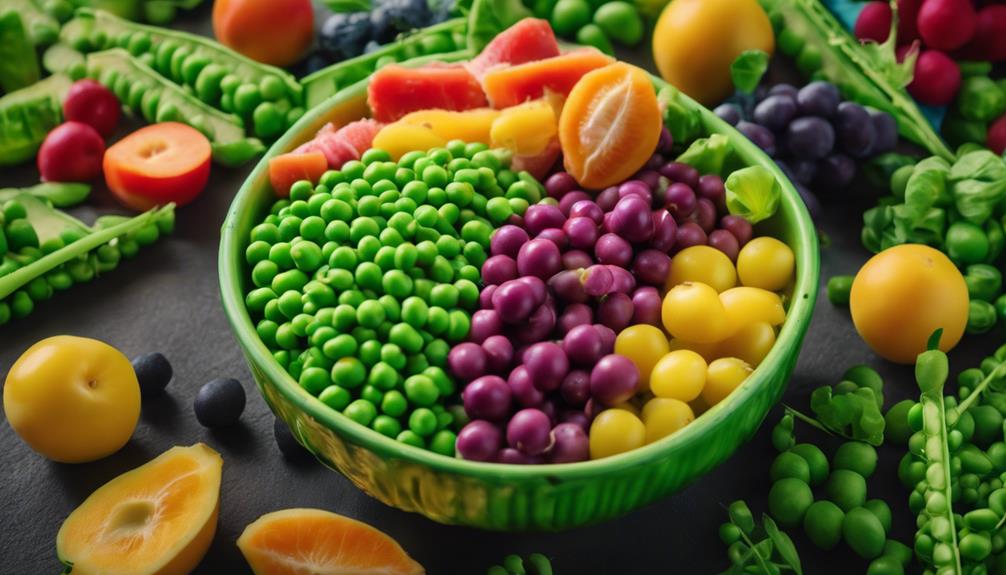
When considering the dietary aspects of incorporating peas into dogs' meals, it is essential to understand the comprehensive nutritional profile they offer to support overall health and well-being.
Peas are rich in vitamins A, K, and C, providing essential antioxidants and a good source of iron. Additionally, peas are high in fiber and protein while being low in calories, making them a nutritious addition to a dog's diet.
The fiber content in peas supports digestive health, while the protein aids in weight management and muscle maintenance. Furthermore, the vitamins and antioxidants present in peas contribute to regulating blood sugar levels, promoting heart health, and boosting immunity in dogs.
Health Benefits of Peas
With their abundance of essential nutrients, peas offer a multitude of health benefits that can positively impact a dog's overall well-being. Rich in vitamins A, K, and C, high in fiber and protein, and low in calories, peas provide antioxidants and are a good source of iron.
These nutritional qualities contribute to supporting digestive health, aiding in weight management, regulating blood sugar levels, promoting heart health, and boosting immunity. Including peas in a dog's diet can help maintain a healthy and balanced lifestyle.
However, it is essential to monitor portion sizes and consult a veterinarian to ensure that peas are introduced in a safe and appropriate manner tailored to the individual dog's needs.
Other Dog-Friendly Vegetables
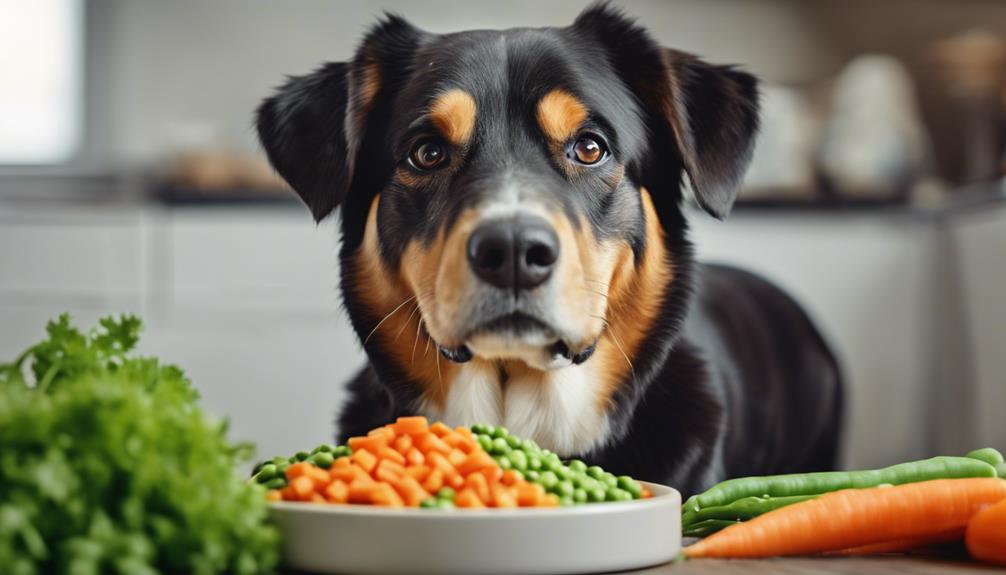
To expand on the variety of nutritious options for dogs, consider incorporating additional vegetables into their diet that are safe and beneficial for their health. In addition to peas, there are other dog-friendly vegetables that can provide valuable nutrients and variety to their meals:
- Spinach: Rich in iron and vitamins A, C, and K.
- Bell peppers: Packed with vitamin C and antioxidants.
- Cucumbers: Low in calories and a refreshing snack option.
These vegetables can be served raw or lightly cooked to preserve their nutritional value and ensure easy digestion for your furry friend. Remember to introduce new vegetables gradually and monitor your dog for any adverse reactions.
Preparation of Peas for Dogs
Peas for dogs should be thoroughly cooked to ensure optimal digestibility and safety. Cooking peas softens them, making it easier for dogs to chew and digest.
When preparing peas for dogs, it is important to ensure they are fully cooked to avoid any potential digestive issues or choking hazards. By cooking peas, you can also enhance their flavor and make them more appealing to your canine companion.
Additionally, thoroughly cooked peas are less likely to cause allergies or other adverse reactions in dogs. Overall, taking the time to properly cook peas before serving them to your dog is a crucial step in ensuring that they can enjoy this nutritious vegetable safely and comfortably.
Serving Suggestions for Peas
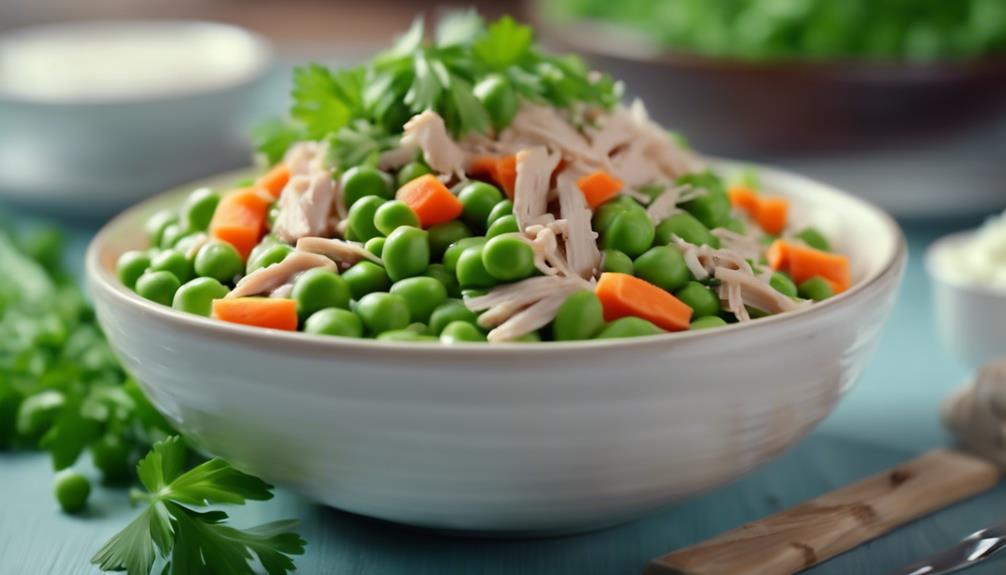
When considering incorporating peas into a dog's diet, it is essential to explore various serving suggestions that can enhance the nutritional value and appeal of this vegetable to your canine companion. Peas can be a versatile and nutritious addition to your dog's meals.
Here are some serving suggestions to consider:
- Mix cooked and mashed peas with your dog's regular food for added fiber and nutrients.
- Freeze peas as a refreshing treat on a hot day.
- Blend peas into homemade treats like biscuits or muffins for a healthy snack alternative.
These serving ideas can help make peas more palatable and enjoyable for your furry friend while providing them with essential nutrients.
Risks of Feeding Peas
Feeding peas to dogs may pose potential risks, including digestive issues, allergies, and the danger of excessive consumption. Peas contain fiber that can sometimes lead to gastrointestinal upset, especially if introduced in large quantities or if the dog has a sensitive stomach. Additionally, some dogs may be allergic to peas, experiencing symptoms like itching, skin irritation, or digestive disturbances.
Overfeeding peas can result in an imbalance of nutrients or contribute to weight gain due to their carbohydrate content. Monitoring the dog's reaction to peas and introducing them gradually can help identify any adverse effects. Consulting a veterinarian before incorporating peas into a dog's diet is advisable to address individual concerns and ensure the safety of feeding peas.
Potential Risks and Considerations
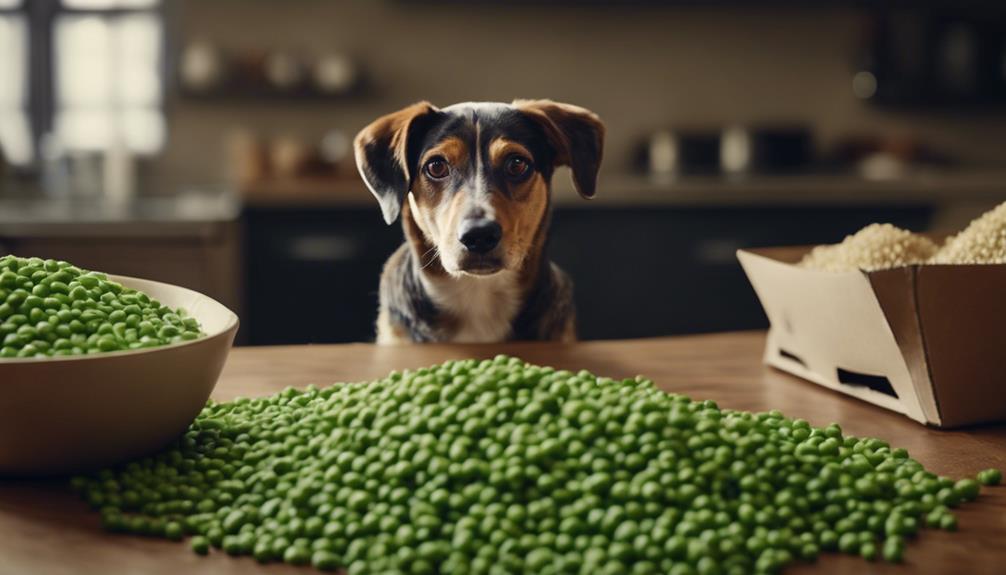
Considering the potential risks and considerations associated with introducing peas into a dog's diet, it is important to be mindful of the digestive implications, allergies, and the impact of excessive consumption on the overall health and well-being of the canine companion.
- Digestive Implications: Peas, especially if not cooked properly, can lead to digestive issues like gas or bloating in some dogs.
- Allergies: While rare, some dogs may be allergic to peas, leading to symptoms such as itching, skin irritation, or gastrointestinal upset.
- Excessive Consumption: Overfeeding peas can result in an imbalance in the dog's diet, potentially causing nutritional deficiencies or weight gain.
It is crucial to monitor a dog's response to peas and consult a veterinarian if any concerns arise.
Likelihood of Allergies to Peas
Peas are a relatively uncommon allergen for dogs, but it is important for pet owners to be aware of the potential for allergic reactions when introducing this vegetable into their dog's diet. Allergic reactions to peas in dogs can manifest as itching, digestive issues, or even more severe symptoms. Below is a breakdown of factors influencing the likelihood of allergies to peas in dogs:
| Factor | Influence |
|---|---|
| Breed predisposition | Certain breeds may have a higher likelihood of developing pea allergies |
| Overall health | Dogs with weakened immune systems may be more prone to allergies |
| Previous food allergies | Dogs with a history of food allergies may be at a higher risk |
Taste Preferences of Dogs
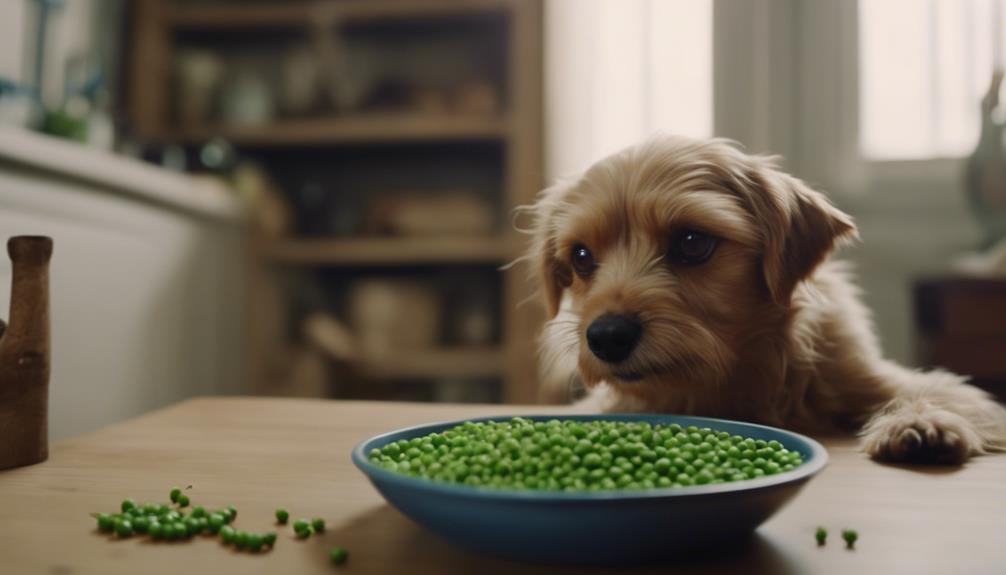
When introducing peas into a dog's diet, understanding their taste preferences is crucial for ensuring acceptance and enjoyment of this nutritious vegetable. Dogs, like humans, have varying taste preferences, and some may be more receptive to peas than others.
To help you gauge your dog's potential reaction to peas, consider the following:
- Some dogs may enjoy the sweet and slightly crunchy texture of fresh peas.
- Others might prefer peas served frozen as a refreshing treat on hot days.
- Mixing peas with other dog-friendly foods can enhance the overall appeal and palatability of this vegetable, making it more likely for your furry friend to indulge in this nutrient-rich treat.
Importance of Veterinary Consultation
Seeking guidance from a veterinarian is imperative prior to introducing new foods like peas into a dog's diet. Veterinarians play a crucial role in assessing a dog's overall health, dietary requirements, and potential food sensitivities. They can provide personalized recommendations based on the dog's age, breed, weight, and any existing health conditions.
Consulting with a veterinarian before incorporating peas into a dog's diet ensures that the legume is safe and suitable for the individual dog. Additionally, veterinarians can offer guidance on portion sizes, preparation methods, and potential risks associated with feeding peas to dogs. By seeking professional advice, pet owners can make informed decisions that promote their dog's well-being and prevent any adverse reactions to new foods.
Dietary Considerations for Dogs
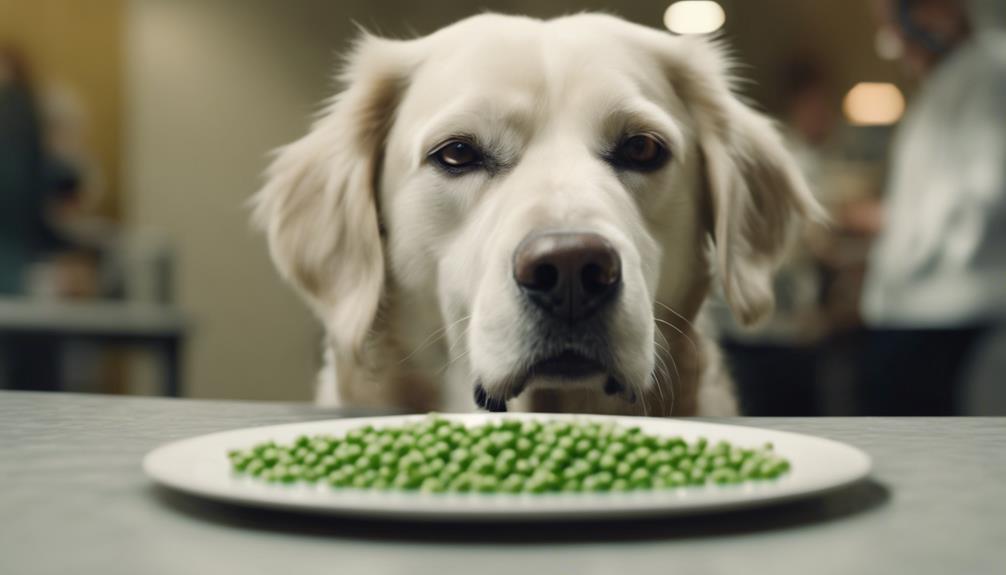
Understanding the nutritional needs of dogs is essential for maintaining their overall health and well-being. When considering dietary options for dogs, it is crucial to keep in mind the following points:
- Balanced Diet: Dogs require a well-balanced diet consisting of proteins, fats, carbohydrates, vitamins, and minerals to thrive.
- Hydration: Adequate water intake is vital for dogs to support various bodily functions and prevent dehydration.
- Avoid Harmful Foods: Certain foods like chocolate, grapes, onions, and garlic can be toxic to dogs and should be strictly avoided in their diet.
Portion Control and Peas
What considerations should be made when determining the appropriate portion size of peas for dogs?
Portion control is crucial when feeding peas to dogs. While peas offer various health benefits, including fiber, protein, and vitamins, overfeeding can lead to digestive issues and potential health risks.
As a general guideline, peas should only make up a small portion of a dog's overall diet. The exact amount of peas to feed your dog depends on factors such as the dog's size, breed, and individual dietary requirements.
Consulting with a veterinarian is recommended to determine the suitable portion size of peas for your dog, ensuring that it complements their existing diet without causing any adverse effects. Remember, moderation is key when incorporating peas into your dog's meals.
Conclusion
In conclusion, the inclusion of peas in dogs' diets can offer numerous nutritional benefits, such as fiber, protein, vitamins, and antioxidants.
While peas can be a healthy addition to a dog's meal plan, it is essential to consider serving sizes, preparation methods, and potential risks.
Consulting with a veterinarian for tailored dietary guidance is crucial to ensure that your furry friend receives a balanced and wholesome diet.




